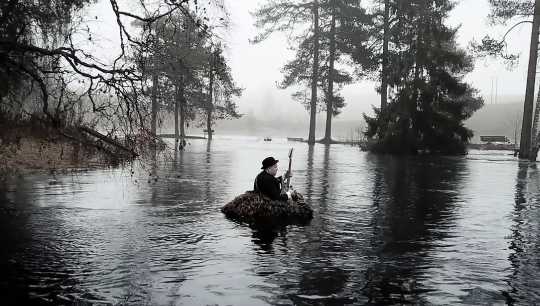|
This is a brilliant piece of work by an extraordinary musician; for me, his greatest yet.
It is astonishingly ever-changing in sound and direction, not just from track to track but within each track. While it sparks all kinds of images and resonances, there’s not a cliché nor a predictable development to be found.
Norway’s Carstensen, of the wonderful, witty band Farmers Market and creator of a slew of solo projects and collaborations, is that rare thing, a genuine multi-instrumental virtuoso polymath. He’s a master of accordion, banjo, kaval, pedal steel, guitar and more, with wide experience in several musical genres, including the Norwegian accordion and fiddling traditions of generations of his family, and the dazzling, asymmetric rhythms of the accordion and kaval music of Bulgaria and other parts of the Balkans where he’s frequently traveled, and adding to them high skills in classical music and jazz.
Where to begin to describe its overwhelming variety?
It opens in “Musette Epithalamus” with a rolling military snare-drum and timpani beat and wild reeds, switching on a sixpence (OK, dime) into bassoon that opens up a sort of renaissance band march, that morphs in and out of scampering variations on a diversity of instruments including tubular bells, glockenspiel, bagpipes, kaval, banjo, accordion, guitars, cello, cimbalom, and string trio, then suddenly ends with a slithering pedal steel solo reminiscent of Area Code 615.
That’s all just in the first track of eleven that, in the vinyl release, runs to two LPs. Each piece has enough material to soundtrack a whole film. Indeed Carstensen and company have released a surreal video of the second track, “Hippocampus Serenade.”
“Synaptic Saltarello” opens with synths and ocarina that lead with kaval into the asymmetric rhythms of Bulgaria, joined by 12-string-guitar power chords of a Pete Townsend disposition, then by a chugging mass that might include guitars, bassoon, Hammond organ and more, before thinning suddenly into an airy wind ensemble including French horn before the heftier chugging stabs return, spiralling kaval and other wind emerging in continuation of the winding melody. A quivering continuo precedes an closing set of chords that hang unresolved.

|
|
Limpid harp begins “Medulla Galliard” in an elegant almost Scottish/Irish/Nordic melody that’s soon augmented by a pedal-steel led ensemble, and then also by gutty drums that point up aspects of the melodic line rather than pinning it down to a steady beat. A pause back to the harp, that now hints at an Indian raga scale, and indeed is soon joined by electric sitar-guitar. And we’re still only two minutes into a seven minute piece, as squeeing synth dances up high with the pedal steel, moving to a sort of jazz-rock style section that reminds me of the great but under-celebrated UK band Second Vision. Now it’s a reflective period of harp and cello, pivoting with the entry of the husky, breathy kaba-tone of kaval into a yearning Bulgarian type of theme. 12-string guitar arpeggios, harp glisses, synth soar, and sampled choral voices combine for a summing-up ending.
“Thalamus Canticum” is a song, with the falsetto voice of multi-skilled Brit Jacob Collier in lyrics, in English, by Simon Dancaster, accompanied just by Carstensen’s guitar and pedal steel, Auden Sandvik’s cello, Marinette Tonnin-Olsen’s French horn and what seems to be, prominent yet not listed for this track, Sidsel Walstad’s harp. The first stanza goes: ‘Come hither, ye sons of Sodom, see fair Lis shine in full morning bloom. Comeliest maiden of Gomorrah, fa-la-la-la-la-la. Her piercing eyes make even brave hearts swoon.’
Later in the album there’s another song, “Hydrocephalus Epilogue,” in which Mike Patton of US band Faith No More dramatically sings and whispers lyrics in Italian by Dancaster (known for the lyrics he’s written for Norwegian black metal bands), Mia Wallace and Patton himself, that talk of a soul tormented by demons and wishing for trepanation to release them from his head.
“Bolero Oblongata” opens with percussion and deep-twangy baritone guitar in an angular groove, taken up by strings, in a kind of maqam mode with an aura of Egypt or Sudan, over whose hefty rhythm a keening fuzz-toned pedal steel zooms.
“Ritornello Amygdala” is a Bach-like quartet piece of Hammond organ, bassoon, violin and banjo. “Pineal Prelude” limpid harp leads into a calm cello, still slowly swaying but made less calm low and ever-lower growling baritone electric guitar line. The nine-minute “Cortex Courante” moves through pattering harp, smearing pedal steel, via chunking Hammond and harpsichord under strings, sudden massed male voices, bursting into wild screaming electric guitar and synth with bass and kit drums, in full jazz-rock band mode, before a return to the harp and pedal steel serenity.
For the eight-minute closer, “Tarantella Cerebellum,” it’s the military snare and timpani of the opener beginning something of a recapitulation of earlier themes and sounds, but everything pauses for a rolling, skittering cimbalom solo from Giani Lincan, before the big-sound dancing melody returns, pausing again for a section of rippling harp and Arve Henriksen’s well-known and distinctive floating, misty trumpet, blending with keyboardist Torbjørn Dyrud’s high wordless vocal.
If this is seeming an over-detailed description, I’m not even coming close to all that’s happening in these tracks. Never even a hint of a dull moment, just constant inventiveness and surprise. Genuinely, awesomely wonderful.
Photo: Eric Hannemann
Find the artist online.
Further reading and listening:
Farmers Market - Slav to the Rhythm
Martha Mavroidi Trio - Portaki
Search RootsWorld
|
